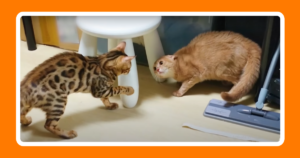You know when you bring a new cat home, it’s not just about welcoming a new furball – it’s like stepping into their wild side and getting to know Warnings Your Cat Needs a Slower Introduction! Cats have this thing about claiming their space; it’s like they’re saying, “This is my spot, buddy!” So, when you understand their need to mark territory, you’re basically speaking their language and addressing cat behavior. It’s all about creating a chill vibe where everyone feels at home, and, more importantly, understanding cat signs.
Ever wondered why cats are so territorial?
You know, it’s all about survival instincts! Cats are territorial animals at heart. Back in the wild, claiming territory was all about securing food and shelter. That urge to mark their turf? Totally natural. Even our cozy house cats keep up the tradition, showing off their wild side. It’s like they’re saying, “This is mine, and I’m in charge!” So, when you catch your cat patrolling or guarding their space, it’s just their instincts shining through!
Warnings Your Cat Needs a Slower Introduction
1. Hissing and Growling:
Hissing and growling between cats during introductions are clear indicators of tension and discomfort. It’s essential to address these signs promptly to prevent escalation.
2. Puffed-Up Fur:
When a cat’s fur is puffed up, it’s a defensive reaction to feeling threatened or frightened. Recognizing this body language is crucial for understanding your cat’s emotional state during introductions.
3. Avoidance Behavior:
Cats may actively avoid each other or hide away when they’re feeling uneasy about an introduction. This behavior signals that they’re not ready to interact yet and may need more time to adjust.
4. Aggressive Body Posture:
Aggressive body postures, such as flattened ears, dilated pupils, and a tense body stance, indicate that cats are feeling defensive or threatened. Addressing these signs early on can prevent conflicts during introductions.
5. Lack of Progress:
If despite your efforts, you’re not seeing any improvement in your cats’ behavior over time, it may be a sign that they need a slower introduction process. Rushing the process can lead to prolonged stress and hinder the chances of successful cohabitation.
The Importance of Recognizing Cat Signs
Recognizing warning signs and cat behavior during cat introductions is crucial for preventing conflicts, cat anxiety and ensuring the well-being of all cats involved. By addressing these signs early on, you can cure cat anxiety symptoms and take proactive steps to create a positive and stress-free environment for your feline companions.
How to Proceed with a Slower Introduction Strategy

1. Assessing the Situation
Take a look around your home and see how things are shaping up with your furry buddies. Think about your existing cat’s personality – is he a laid-back lounger or a feisty furball? Consider the age and character of your new cat too. Have they been through introductions before? Knowing these details will help set the stage for a smoother meet and greet.
2. Creating a Safe Environment
It’s like setting up a cozy kitty retreat! Prep a special spot just for your new cat, complete with all the kitty essentials – food, water, a litter box, and cozy hideaways. Make sure it’s tucked away in a quiet corner, far from your existing cat’s turf. This way, everyone can chill out without stepping on each other’s paws.
3. Scent Introduction
Time to play matchmaker with scents! Swap a blanket or a toy between your cats so they can get a whiff of each other’s scent. It’s like leaving love notes for them to sniff out, making them curious about their new housemate without even meeting face to face.
4. Supervised Interaction
Ready for the big moment? Once your cats start showing interest in each other’s smells, it’s time for a supervised playdate. Keep things short and sweet, letting them suss each other out at their own pace. Think of it like a kitty coffee date – casual, no pressure, and plenty of room to explore.
5. Positive Reinforcement
Time to break out the treats and kitty compliments! Whenever your cats share a friendly sniff or a playful swat, shower them with praise and goodies. It’s like giving them a high-five for getting along and showing them that good behavior comes with tasty rewards.
Conclusion
Introducing cats to each other requires patience, understanding, and careful observation of their behavior. By recognizing warning signs indicating that your cats may need a slower introduction process, you can take proactive steps to ensure a smooth transition and harmonious coexistence.
As cats have a territorial problem, It will be helpful for your cat and you can prevent early cat signs of stress when introducing cat to a new home.



